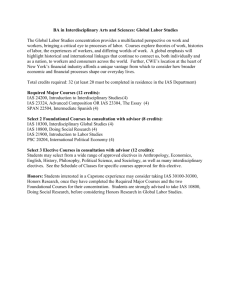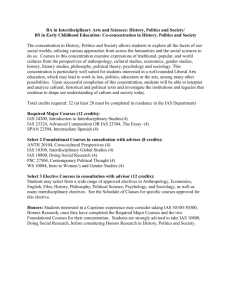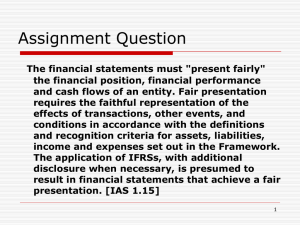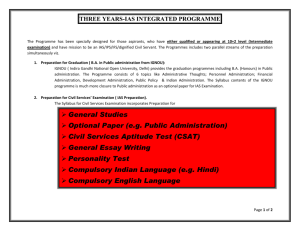Introduction to Invasive Alien Species
advertisement
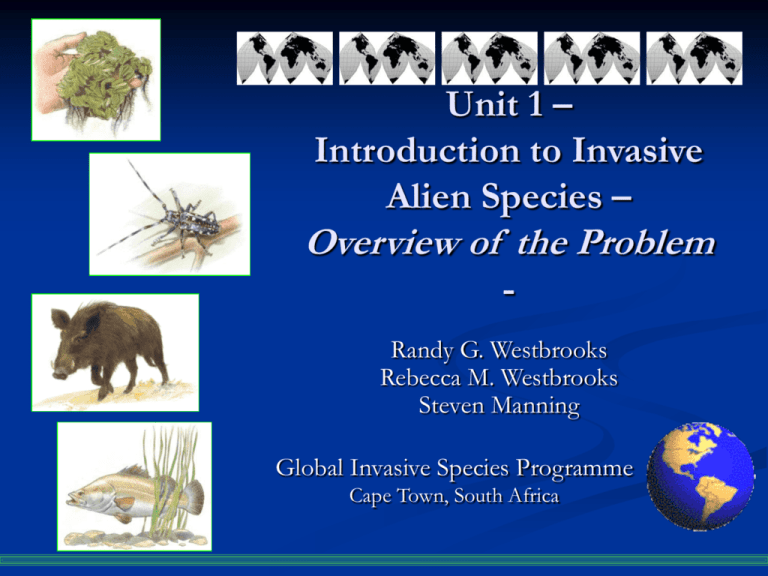
Unit 1 – Introduction to Invasive Alien Species – Overview of the Problem Randy G. Westbrooks Rebecca M. Westbrooks Steven Manning Global Invasive Species Programme Cape Town, South Africa Unit Objectives Understand and describe the nature of the IAS problem List some of the major characteristics of IAS Discuss a few of the world’s worst IAS Discuss the basic ecological, economic and public health impacts of IAS Describe the process of biological invasions Give examples of intentional and unintentional introductions List major pathways and vectors of primary and secondary spread Explain difficulties with predicting invasiveness of organisms Discuss some of the factors that are enhancing the global spread of IAS Session Outline and Agenda 1100-1125. Session 1. Introduction to Invasive Alien Species. 1125-1145. Session 2. Human Facilitated Spread of Plants and Animals – “Who’s Using Who?” 1145 – 1200. Lab Exercise. 1200 – 1300. Lunch. 1300-1330. Session 3. Predicting Invasiveness – Forewarned Is Forearmed! 1330-1400. Session 4. Factors Enhancing the Spread of IAS. 1400-1445. Lab Exercises. 1445-1450. Review of Major Concepts in Unit 1. 1450-1500. Break. Session 1. Introduction to IAS. 1.1. Overview of the Problem. Crop Pests – Historic Struggle Between Man and Nature Invasive Alien Species (IAS) – Plants/Animals Outside their Native Range – Due to Trade and Travel Ecological Impacts – Hydrology, Sediments, Soil & Water Chemistry, Disruption of Fire Cycles Economic and Social Losses - $300+ Billion Globally, Deplete Water Supplies, Famine/Disease, Grazing Lands, Noise Pollution Ports of Entry – First Line of Defense Against IAS 1.1.2. IAS - Ecosystems out of Balance Origin of IAS Remove Top Predators Insert New Exotic Species Without Co-Evolved Predators and Parasites Food Web Beaver Simple Food Chain Eastern Gray Squirrel 1.1.3. Evolution in Isolation – Recreation of a Virtual Pangaea Super-continents Evolution in Isolation Columbia 1.5 Billion Yr BP Rodinia 700 Million BP Pangaea 180 Million Yr BP Ecological Explosion 8,600 Birds (4X #) Global Spread of IAS Recreating a Virtual Pangaea Homogeocene Pangaea 1.2. Characteristics of IAS. Abundant in Natural Range History of Invasiveness Outside Natural Range Wide Distribution in Different Habitats Fast Growth, Early Maturity High Reproduction; Seed Dormancy Allelopathy Prickles, Spines, Thorns Parasitism Same Size/Shape as Crop Seeds Ability to Go without Food/Water Roots/Rhizomes with Large Storage Efficient Means of Spread Close Association with Humans Purple nutsedge (Cyperus rotundus) – the perfect weed. 1.3. Characteristics of Invaded Habitats. Ecological Similarities Between Origin and Receiving Ecosystems Lack of Co-evolved Predators and Parasites Other IAS already A Established High Degree of Disturbance Secondary Pathways and Vectors for Further Spread B A. Wet Tropics of Queensland, Australia. B. Florida Everglades, United States. 1.4. Overview of IAS Taxa Groups. Invasive Plants, Insects, Diseases, Aquatic Nuisance Species, and Injurious Wildlife. 1.4.1. Invasive Plants. 250,000 Plants in the World 22,000 Invasive Plants Definitions Invasive Plant = Weed Noxious Weed = Regulated Weed Melaleuca and Pond Apple – Tale of Two Weeds in North America and Australia Melaleuca Pond Apple 1.4.2. Insects. 30 Million Insect Species 500,000 Species of Beetles Desert Locust Africa, Middle East, Asia Swarms – 1,200 km2 96 Billion Individuals 240,000 Metric Tons Losses Morocco – 1954 ($50 Million in 6 Weeks) Ethiopia – 1958 (167,000 Tons of Grain – Feed 1 Million People for a Year Mauritania, July, 1994 1.4.3. Aquatic Nuisance Species. ANS Factoids 21 Billion Gallons Ballast Water Per Year (USA) 3,000 ANS Moving in Ballast Water Around the World ANS Taxa Aquatic Weeds (Water Hyacinth) Aquatic Invertebrates (Zebra Mussel) Aquatic Vertebrates (Nile Perch) 1.44. Injurious Wildlife Terrestrial Vertebrates Intentionally Established Game Animals Domestic Animals IW Examples Nutria Eastern Gray Squirrel Australian Brushtail Possum 1.5.1. Ecological Impacts of IAS. Threaten Endangered Species Crowd out Natives Compete with Natives for Resources, Space, Light Disrupt Trophic Level Relationships Increase Disturbance Regimes that Natives are not Adapted to (e.g., Wildfires) Hybridize with Natives Cause Habitat Loss Fynbos – South Africa Argentine Ant Old World Climbing Fern in Florida Cheatgrass in the American West Mallard Duck 1.52. Economic Effects of IAS. USA: $150 Billion India: US$117 Billion South Africa: US$17.5 Billion United Kingdom: US$12 Billion Australia: AUS$10 Billion New Zealand: US$10 Billion Africa (Aquatic Weed Control): $US60 Million 1.5.2.2. Economic Impacts of IAS. Direct Losses Crop Losses (India – 20% Per Year) Loss of Exports Loss of Pasture Productivity Cogongrass Loss of Fisheries Karnal Bunt of Wheat Nile Perch Indirect Losses Flooding (Water Hyacinth) Landslides (Miconia) Damage to Dams (Nutria) Increased Wildfires (Cheatgrass) Loss of Tourism (Spotted Knapweed) 1.53. Public Health Impacts. Diseases 1999 - West Nile Virus USA 9,862 People Infected 264 People Died 2003 SARS in China $17 Billion Tourism Losses Stings - Allergic Reactions Imported Red Fire Ant Africanized Honey Bee Session 2. Spread of Plants and Animals – Who’s Using Who? Reversion of Cultivars to Wild Forms Olives Granny Smith Apple 1.6. Process of Invasion. Primary Introduction Establishment Monterey Pine in NZ, AUS Secondary Spread Vehicles, Trains, Trailers, Animals 1.6.2. The IAS Lag Phase. Melaleuca in the Florida Everglades. Florida Everglades River of Grass, Tree Islands 80 Miles wide, 1/3 M Deep 1906 – Introduced from AUS 1936 - Aerial Seeding with Melaleuca 1970s – Rapid Spread throughout the Glades 1990s – 200,000 ha Infested 1.7. Intentional Introductions. 1.7.1. Introductions that become Invasive. Agricultural Crops Forestry Species Cordia - Vanuatu Ornamental Plants Kudzu - USA Aid Trade Leucaena - Africa Erosion Control Tall Fescue - Pastures Siam Weed - Africa Germplasm Disease Infected Wheat 1.7. Intentional Introductions. 1.7.1. Introductions that become Invasive. Game Animals Mammals as Food Source on Islands Nile Perch – Lake Victoria, Africa Pets Released in Wild Cane Toad - AUS Fishery Releases Feral Pigs, Goats Biocontrol Agents Sika Deer - USA Burmese Python - USA Aquaculture Escapes LA Crayfish - Africa 1.7.1.2. Unauthorized Intentional Introductions (Smuggling). Chinese Water Spinach (Ipomoea aquatica) 1.8. Unintentional Introductions. Adaptations for Spread Stowaways Khapra Beetle Hitchhikers Plants – Burs (Cocklebur), Seed Sails, Floating Seeds Animals – Dog Tick Snails Khapra beetle Contaminants (Comingled) Weed Seed in Crop Seed Jointed Goatgrass in Wheat 1.8. Unintentional Introductions. Contd. Hitchhikers on Nursery Plants Hitchhikers on Cut Flowers Crazy Yellow Ant Ballast Soil and Water Giant African Snail Mail Clemora smithi (Sugarcane White Grub) Transferred from Barbados to Mauritius in Sugarcane Planes, Trains, Vehicles, Equipment Leaf Miners Soil Pests Pink Hibiscus Mealybug Chinese Mitten Crab Hull Fouling Organisms Case Study: Yellow Crazy Ants on Christmas Island 1930 – Introduced to Christmas Island* 1990s – Population Exploded Forms Multi-Queen Super Colonies Up to 700 ha in Size Overwhelms and Kills Native Species Red Land Crabs 1995-2002 - 10-20 Million Killed Robber Crabs, Native Reptiles Native Invertebrates Control – Toxic Bait – 99% Effective Fipronil in Fish Meal (0.6 gm/ha) *1528 km NW of AUS; Possession of AUS 1.8.1. Case Study: Serrated Tussock in the U.S. Description: Annual Grass Origin: Argentina Threat: Serious Pasture Weed, Minimal Nutrient Value Areas Affected: AUS, NZ 1989 Introduction to USA Nine Infested Shipments from ARG Loophole in FNWA – Seed Shipments Exempt from Regulation under the Law Federal Judge Ruled Intent of Law Included Seed Shipments Results Large Amount Re-exported to Canada, Japan 5,000 kg (11,000 lbs.) Burned in Kentucky 6,800 kg (15,000 lbs.) Buried in Landfill in Missouri Small Amount Hydroseeded onto Stripmine Reclamation Sites in Kentucky 1.9.1. Pathways of Unintentional Spread. Commercial Shipping People Movers Ships Planes Trains Vehicles – Trucks Ships, Planes, Trains, Vehicles People Beggar-lice on Trousers 1.9.2.2. Unintentional Spread by Cargo and Commodities. Cargo – Wide Range of Commercial Goods Military Equipment Commodity – Homogeneous Substances in Commerce Imported Fruit Ornamental Rocks Unit 1 – Lab Exercise 1. IAS in Participant Countries. 1. Name five introduced species in your country that are not considered to be invasive. 2. Name five introduced species in your country that are considered to be invasive. Lunch! Sponsored by: Dr. Lynn Jackson Global Invasive Species Programme Capetown, South Africa Session 3. Predicting Invasiveness. 1.10. Methods of Predicting Invasiveness. Criteria for IAS Prevention Program Know About IAS Worldwide GISP: http://www.gisp.org/ Global Invasive Species Database: http://www.issg.org/database/welcome/ Know Which Ones Pose a Threat to Your Country Characteristics of Ideal Invaders Session 3. Predicting Invasiveness. 1.10. Characteristics of the Ideal Invader. Widespread in Native Range (Kudzu in China) History of Invasiveness Elsewhere (Serrated Tussock in Australia) Adapted in Wide Range of Environments and Soils (Tropical Soda Apple) Rapid Growth and Maturity (Cactus Moth) Produces Many Offspring (Desert Locust) Rapid Colonizer (Giant Salvinia) Efficient Dispersal Mechanisms (Jointed Goatgrass in Wheat) Broad Diet (Coqui Frog) Aggressive Behavior (Imported Fire Ant) Close Relationship with Humans (Oriental Cockroach) Small in Size (Khapra Beetle) April 5, 2005 July 13, 2005 Session 3. Predicting Invasiveness. 1.10. Susceptibility of Environments to Invasion. Similarities between Native Range of IAS and Receiving Region IAS Already Established in the Region Level of Development and Disturbance Low Biodiversity Due to Habitat Loss or Stressors such as Over Grazing, Wildfires, Clear Cutting, Water Pollution Vectors for Secondary Spread Isolated Communities with High % Endemic Species Session 3. Predicting Invasiveness. 1.10. IAS Risk Assessment. Regulatory Prevention Pest Risk Assessment Systems*. USDA APHIS Weed Risk Assessment System AUS AQIS Weed Risk Assessment System Prohibited Listing Approach Permitted Listing Approach - 49 Questions Score < 1 (Permitted Entry) Score 1 – 6 (Evaluated Further) Score > 6 (Prohibited Entry) Ranking of Established IAS NatureServe I-Ranking (400 Species Ranked) *More in Unit 7. Session 4. Factors Enhancing Spread of IAS. 1.11. IAS and Globalization. The Global Village Instant Communications Global Trade, Travel Homogenization of World’s Flora & Fauna Species Introductions – Social, Economic Reasons The ‘Homogeocene’ Homogenizing the World’s Flora and Fauna......... Our Legacy? The Great American Exchange Panama Land Bridge, 3 Million Yr. BP North American Mammals South American Marsupials Session 4. Factors Enhancing Spread of IAS. 1.12. IAS and Changing Land Use Patterns. Human Development and Habitation - Civilization Nutrient Rich Urban Lawns and Gardens (Chinese Wisteria) Higher # IAS Around Population Centers Habitat Fragmentation, Attract Wildlife, Attract IAS Source Areas for Horticultural IAS More People = More IAS Purple Loosestrife – Campbell Creek, Anchorage, Alaska Roads and Highways Connecting People – Spreading IAS Japanese Hops, Connecticut, USA Johnsongrass, North Carolina, USA Dar es Salaam, Askari Monument 1.13. IAS and Global Climate Change. Cause and Effect. Land Use Changes (Habitat Fragmentation and Destruction) Build up of Greenhouse Gases (Global Warming, Sea Level Rise, Ecosystem Demise) Air & Water Pollution (Threat to Environmental/Human Health Spread of Invasive Species (Threat to Biodiversity and Agricultural Production) Pleistocene Interglacial Periods. Natural Climate Change Events in North America. 1.8 Million – 11,500 Years Ago. Average Temperature 2-3o C Higher Plants/Animals Migrated North South American Tapirs in North Carolina Sweetgum in Canada Manatees in New Jersey Potential Impacts of Modern Global Warming Temperatures Drought, Heat Waves Hurricane Katrina Sea Level Rise Melting Glaciers Melting Snowcaps More Rainfall, Storms, Hurricanes 4-9o C Higher 0.4 - 0.5 m Disturbance and Change….. Mt. Kilimanjaro stripped of its snowcap for the first time in 11,000 years. Potential Impacts of Global Warming on Natural Ecosystems. Disappearance of Sensitive Habitat Eastern Forests Changes Alpine Meadows Mixed Woodlands and Grasslands Northwestern Forests Lose Key Species over Decades Species Attempt to Migrate North……. Species Migrations In Response to Global Climate Change. Vegetation Zones Shift 300 km Towards the Poles Loblolly Pine Distribution Move 300 Miles Northward Impediments to Species Migration. Climate Change Faster than Species can Migrate (Trees Migrate 20-30 km per Century) Human Settlements, Activities, Development, Highways Invasive Species Move in to Southern Boundary Transition Zones Cogongrass in Alabama Invasive Species in a Warmer World Expand their Range, Invade New Habitats Compete with Stressed Natives Create Synergistic Effects with other Global Changes Chinese Tallow Tree (Triadica sebifera) Human Induced Global Change Cause and Effect Invasive Species Habitat Burning Land Use Destruction Fossil Air & Water Fuels Changes Pollution Invasive Species Elevated Ecosystem Break Down More Fires Invasive Species Drought Invasive Species Invasive Species CO2 Temperatures Rise More Precipitation Invasive Sea Level Rise Species Unit 1 – Major Concepts. IAS have traits that permit them to outcompete native and beneficial species. IAS often invade areas that are very similar to their native range. Over 22,000 invasive plants have been documented. Unlike chemical pollutants that breakdown, biological pollutants multiply and spread. Impact of IAS on Human Health – allergies, infectious diseases, and Stings. Phases of Biological Invasions - Introduction, Establishment, and Spread. The Lag Phase – a Biological Time Bomb. The Precautionary Principle - Most effective way to minimize further problems with IAS. Unit 1 – Major Concepts, Contd. About 1% of all introduced plants will become invasive. About 75% of all invasive plants were intentionally introduced. Pathways of IAS spread -Commercial Shipping, Air, Water, and Overland Travel, People Unintentional Introductions - Cargo and Commodities may become infested Stowaways and Contaminants at the point of origin, or somewhere along the transport to a new region. Best Predictor of Invasiveness – A History of Invasiveness Elsewhere. Factors increasing the spread of IAS - Globalization, Land Use Changes, and Global Climate Change. Unit 1 – Lab Exercise 2. Modeling Exponential Growth of Yellow Starthistle. Year Initial Seedbank Seeds Introduced into Seedbank = Persistent Seedbank (Seeds that will not Germinate Right Away) (96%) Seedlings (Seeds that Germinate and Become Seedlings) (4%) Adult Plants (Seedlings that will Survive to Maturity) (25%) Next Year’s Seedbank = Persistent Seedbank (SB) + Seeds Produced This Year (SP) = (A)(1,000) X SB = (X)(0.96) S = (X)(0.04) A = (S)(0.25) = SB + SP 0-1 2 3 4 5 6 100 1096 96 1050 4 46 1 10.96 1096 10,960 Unit 1. Exercise 3. Pathways, Vectors, Introductions. List major IAS at your port of entry (e.g., Ships, Planes, Vehicles, etc.). List major IAS vectors and origins of introduced pests that pass through your port (Types of Commodities, Ballast Water, etc.). List one authorized intentionally introduced species that has become invasive in your country. Why/when was it introduced? What impacts is it having? List one unauthorized intentionally introduced species (smuggled) that has become invasive in your country. Why/when was it introduced? What impacts is it having? List one unintentionally introduced species (stowaway, hitchhiker, or contaminant) that has become established and invasive in your country. How was it introduced (pathway, vector)? When was it introduced? What impacts is it having? Unit 1. Exercise 4. IAS Risk Assessment. List characteristics of successful invaders. What kind of regulatory pest risk assessment system does your country use (permitted listing approach, prohibited listing approach). Special Thanks: Lynn Jackson and Philip Ivey Global Invasive Species Programme, Cape Town, South Africa Janine Lloyd USGS BRD, Whiteville, NC Graphics, Lay Out, Design Les Mehrhoff University of Connecticut, Storrs, CT – Editorial Review White Sands Hotel and Resort Jangwani Beach, Dar es Salaam, Tanzania


